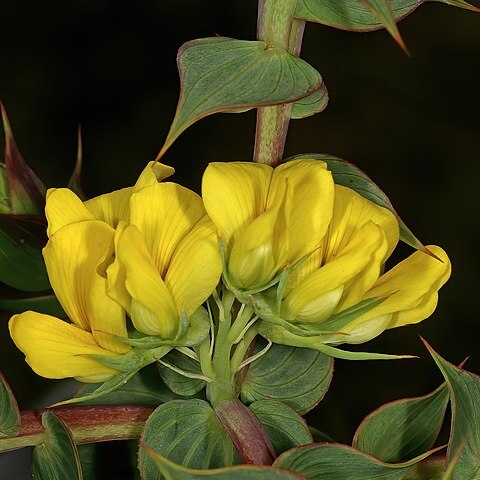A decumbent, ascending or erect shrub 0.2-1.5 m tall, sparingly to closely branched (some forms have a single, erect stem up to 1 m high and spreading branches). Young branches glabrous, angular or compressed, sparsely to very closely leafy; internodes with ridges or narrow wings. Leaves ovate or nearly elliptic, (6-)12-28(-40) x (3-)4-18 mm, stiff, bright green to glaucous, glabrous; base rounded to subcordate; apex mucronate to sharply spine-tipped; longitudinal veins 7-11, surface between these rugose or transversely veined; margin followed by a distinct vein, tuberculate-denticulate (but not with teeth or pegs as in A. perfoliata). Inflorescence a short umbel (or 'head'), rarely a raceme, of 3-15(-25) flowers, ± enveloped by the uppermost leaves. Bract filiform, (0.2-)2.5-9 mm long, 0.1-0.2 mm broad, weak or slightly rigid, glabrous or with few hairs. Pedicel (1.2-)1.5-3.5 mm long, glabrous. Bracteoles (0.2-)2-6 x ±0.1 mm. Calyx campanulate, glabrous, smooth; lobes narrowly triangular-lanceolate, (3-)3.5-8 (-11) mm long, smooth, tapering, acuminate-cuspidate, not prickly. Petals yellow or (standard) partly purplish, turning red or brown. Standard blade obovate, (6.5-)8-13 x (5-)7-14.5 mm, retuse or emarginate, closely sericeous on at least apical half of the back, rarely almost glabrous (see below). Wing blades oblong, (6.3-)7-10(-11) x (2.3-)3-4.5 (-5.8) mm, broadest on apical half, glabrous, with ±6-7 rows of minute folds on basal half or more. Keel blades (4-)4.5-6.5 x (2.3-)3-4(-4.7) mm, glabrous, with ± straight upper margin. Pistil glabrous; ovules (2-)3-5(-9). Pod lanceolate, (15-)22-32 x (4.2-)5-6.5(-7) mm, glabrous, smooth, grey or brown when ripe.
More
Erect or sprawling shrub, 0.2-1.5 m. Leaves 1-foliolate, ovate, subamplexicaul, pungent, margins denticulate, 7-11-veined from base. Flowers 3-15(-25) crowded at branch tips, yellow or standard partly purplish, fading red or brown, wings and keel glabrous, calyx glabrous, lobes narrowly triangular, not prickly.
A shrub. It can lie along the ground. It grows 20 cm to 1.5 m tall. The leaves are 12-28 mm long by 4-18 mm wide. They are stiff and bright green. They can have a sharp tip at the end. The pod is sword shaped and 22-32 mm long by 5-6.5 mm wide. They are grey or brown when ripe.

